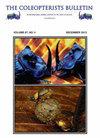觅食习性类型的可能指标:阿根廷五种二叉目(鞘翅目:Scarabaidae)物种的嘴部分析
IF 0.8
4区 农林科学
Q3 ENTOMOLOGY
引用次数: 1
摘要
摘要Dung甲虫表现出广泛的营养偏好,包括软资源和硬资源。对与这些资源相关的口器的研究是广泛的,这些昆虫的口器通常被描述为膜质、多毛,不适合切割坚硬的食物。在这项研究中,我们比较了来自阿根廷的五种Dichtomius Hope的口器(上颚、唇和下咽),这些口器在营养偏好上表现出差异,以评估这些结构是否也因其进食习惯而不同。我们在消耗硬资源的物种[Dichotomius carbonarius(Mannerheim)]中发现了咽上牙齿、下咽牙齿和更多硬化的结构,在消耗软资源的物种[Tichotomium sericeus(Harold)、Dichtomius nisus(Olivier)、Dichotomius mormon(Ljungh)和Dichotomis depressicollis(Harold。另一方面,与这些软资源相关的后一种物种具有更多毛、更柔软的口腔结构。根据这些结果,对口器宏观结构的详细研究可以先验地表明一个粪甲虫物种所消耗的资源状态:牙齿和硬化结构的存在与否分别与硬食物或软食物作为主要资源有关,尽管该领域偶尔会使用其他资源。本文章由计算机程序翻译,如有差异,请以英文原文为准。
Possible Indicators of Feeding Habit Types: Analysis of the Mouthparts of Five Dichotomius Hope (Coleoptera: Scarabaeidae) Species from Argentina
Abstract Dung beetles exhibit a wide range of trophic preferences, including soft and hard resources. The study of mouthparts associated with these resources is extensive, and mouthparts of these insects have generally been described as membranous, hairy, and poorly adapted to cutting hard food. In this study, we compare the mouthparts (epipharynx, labium, and hypopharynx) of five species of Dichotomius Hope from Argentina that show differences in their trophic preferences, to evaluate if these structures also differ according to their feeding habit. We found epipharyngeal teeth, hypopharyngeal teeth, and more sclerotized structures in species that consume hard resources [Dichotomius carbonarius (Mannerheim)] and the absence or reduction of these structures in species that consume soft resources [Dichotomius sericeus (Harold), Dichotomius nisus (Olivier), Dichotomius mormon (Ljungh), and Dichotomius depressicollis (Harold)]. On the other hand, the latter species have hairier and softer mouth structures associated with these soft resources. According to these results, a detailed study of the macrostructures of mouthparts could indicate a priori the resource state consumed by a dung beetle species: the presence or absence of teeth and sclerotized structures would be associated with hard or soft food as the main resource, respectively, despite the occasional use of other resources in the field.
求助全文
通过发布文献求助,成功后即可免费获取论文全文。
去求助
来源期刊

Coleopterists Bulletin
生物-昆虫学
CiteScore
1.00
自引率
14.30%
发文量
73
期刊介绍:
Founded in 1947 by Ross H. Arnett, Jr., The Coleopterists Bulletin is a refereed quarterly journal, which includes a wide variety of articles on taxonomy and ecology of beetles (Coleoptera). Both members and non-members may submit manuscripts for consideration for publication.
 求助内容:
求助内容: 应助结果提醒方式:
应助结果提醒方式:


